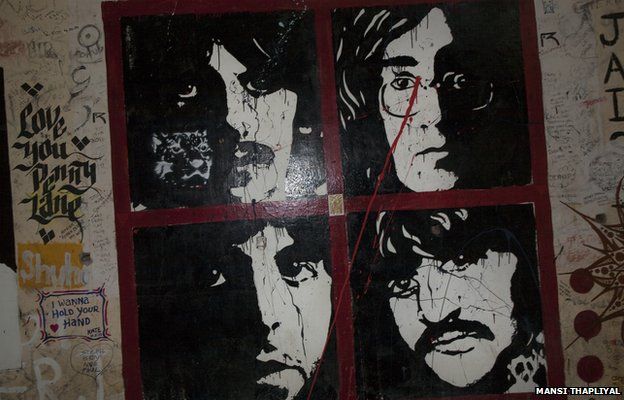BBC News 14 may 2015 by Soutik Biswas BBC News, Rishikesh.

In the wooded hills near India’s holy city of Rishikesh, a 67-year-old British man trudges gingerly through a forest. He is on his way to a derelict ashram where his musical idols once stayed.
He first saw the Beatles in the summer of 1963, he says, when he was one of about 200 people in the audience at a seaside resort. The ticket cost 7d (3p).
Half a century later, he has brought his family from Wales to the ashram on the banks of the Ganges once run by the Maharishi Mahesh Yogi – one of the most flamboyant of the self-styled gurus to emerge from the era of hippiedom.
The Fab Four were there, according to a newspaper report, for a course in “transcendental meditation, which the guru promises can cure anything that ails the Beatles or the world”.
“This place is a pilgrimage for Beatles fans,” says the British tourist. “They come from all over the world. I had to bring my family here.”

The Beatles had planned a three-month-retreat at the sprawling 18-acre estate. According to some accounts, it descended into a fiasco.
Ringo Starr went home after 10 days complaining about the spicy food – even though he had packed a suitcase full of baked beans. His wife, Maureen, also had a phobia of flies, and both missed their children.
Paul McCartney stayed for a month, while John Lennon and George Harrison left abruptly after six weeks – there were financial disagreements, apparently, and there have long been unverified reports of the Maharishi groping another guest, the actress Mia Farrow. Lennon later wrote a scornful song, Sexy Sadie, about the guru. “Sexy Sadie, what have you done? You made a fool of everyone,” goes one line.


Other accounts are more upbeat. Paul Saltzman, author of The Beatles in Rishikesh, says the band wrote some 48 songs in fantastic burst of creativity, many of which made it on to the White Album.
“I was there when they were working on Ob-La-Di, Ob-La-Da,” says Saltzman, who spent two weeks at the ashram.
“Then it was grass and gardens. There were monkeys and emerald green parakeets in the trees.”
Today the ashram is a ghostly relic of those days.
Mildewed and grotty stone and concrete buildings peep out of overgrown bushes and thick forests in a national park where some 1,700 elephants live, alongside tigers and leopards.
But the place remains a big draw with Beatles fans. A dilapidated meditation hall christened The Beatles Cathedral Gallery, by fans has become the beating heart of the ruins. Its walls are ablaze with colourful graffiti, many of them riffing on Beatles songs, “And life flows on with you and without you,” says one.


The roof is peeling off and sunlight streams through the cracks.
Fans sing and play guitar, and a cow lazily ambles out of the woods and across the hall.
A bunch of teenagers in low-slung jeans and tight T-shirts, practise hip-hop dance moves. “We know this place is about the Beatles, but it is good for us too,” one of them says. Outside, in another tumbledown building, a yoga teacher shoots a promotional video.
A Russian fan talks about the Beatles’ “positive energy”, while an Australian student admires the graffiti and hails the band as “rebels”.
Legends about the Beatles’ time here abound.
One has it that Lennon used to live in an orb-shaped stone-floored hut. In reality, the ashram was pretty comfortable, with “ultramodern apartments tastefully furnished with hot and cold water” according to one account – and the Maharishi’s residence was rumoured to have cost £35,000 ($55,000 at today’s exchange rate).

A helicopter flew guests in and out and a special European kitchen served up vegetarian meals three times a day. Among other star guests were singer Donovan and Beach Boy, Mike Love.
According to Donovan, the Beatles wore “embroidered overblouses, fanciful brass pendants, cotton pyjama trousers broadly striped in bright colours, robes for all occasions”. He adds: “They looked like gypsies.”
The Maharishi had promised to turn the pop stars into “fully qualified teachers or semi-gurus of Hindu meditation”. One journalist reported that Lennon and Harrison were on a course of instant mysticism, and being “fed high-level philosophy in simple words”.
The ashram itself – leased to Maharishi by the government in 1957 – was abandoned by the guru and his followers in the mid-1970s and gradually reclaimed by nature. The yogi himself died in 2008.
“The gods have left the place,” says the guard at the main gate, “but the devotees keep on coming.”


The Beatles fly in
The Beatles received a tumultuous reception when they landed in Delhi on their way to Rishikesh, in February 1968.
A “hysterical mob of Delhi’s teenagers gave the mop-headed, lovable Beatles a tumultuous welcome”, reported the Times of India.
“As soon as the announcement of their arrival came over the amplifier system, the teenagers ran helter-skelter, yelling and shouting: ‘They are here, they are here.'”
The Beatles were dressed in their “fancy shirts, their hair as shaggy as ever,” The Statesman noted.
In a Delhi hotel, the Beatles registered under the name of Brown and party. Reporters later found a Sikh sitar player giving lessons to George Harrison, while John Lennon was found trying to play a snake-charmer’s flute.
“Women are just beautiful here,” said Lennon. “In what way?” the reporter asked. “Oh their saris and they just glide. And they are so different,” Lennon replied.

The Times of India reporter asked Lennon whether the Beatles would perform in Delhi.
“Our instruments are not with us,” he said.
“Would you have given a performance if you had your instruments with you?” the reporter persisted.
“We don’t give performances just like that. They have to be arranged beforehand,” Lennon said.
Reaching the end of that line of questioning, the reporter asked about Beatles’ ambitions.
“We don’t have any ambitions,” said Lennon. “We are not a missionary group.”